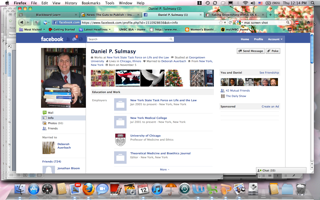Andrea Kalfoglou, Ph.D.
A few years ago (2011), Facebook suggested that I “friend” a member of the bioethics community. After all, 42 of my other Facebook “friends” were also linked to Dr. Daniel Sulmasy. I had worked for Dan on a study over a decade ago, and we kept up at the annual ASBH conferences.
In retrospect, there were a number of oddities about his Facebook page. He had amassed 724 “friends,” and was married to someone named Deborah. As a Franciscan Friar, I knew he had taken a vow of celibacy, but it had been a while since we had talked, and I thought, well, things change. The page looked totally legitimate with a nice picture of Dan, a list of his past employers, and, well, 42 of my bioethics colleagues were his “friends.” He was listed as a member of the New York State Taskforce on Life and the Law when, in fact, he was a member of the President’s Bioethics Commission, but then again, he did live in NYC so it was possible.

He posted occasionally about stem cells and ice cream. I had a couple of “message” (i.e. private) chats with him about the PCB, my kids, and my career. All seemed plausible, except that I knew Dan. Not only was I surprised that he would pay any attention to Facebook, but the “voice” in his messages was off.
In a work related conference call, I asked some colleagues when Dan had gotten married. In a flurry of conversation, I learned that at least five other prominent members of the bioethics community had had false identities created on Facebook around 2008. I checked, and that was the year Dan’s page was created.
I became concerned and sent a screenshot of Dan’s page directly to him via his email account. He confirmed that he had not created the page, and joked about it a bit. It took about a day for the implications to fully sink in. What if faux Dan was having private conversations with colleagues that could damage Dr. Sulmasy’s reputation? I immediately notified Facebook that this was a false identity profile, and the page was removed. But why was it created in the first place? Did someone just want to lurk into the world of the bioethics community? Apparently this happens frequently, and while Facebook will delete the fake profile, they will not notify the 724 contacts that this was not, in fact, Daniel Sulmasy, MD, OFM.
In retrospect, it appears that this identity thief did not have nefarious intentions, and it appears that Dan’s reputation was not damaged. But someone had intentionally infiltrated the bioethics community. After doing a bit of searching, I discovered at least one additional fake profile that appeared to be dormant. I notified the individual and had the profile removed.
So, what is the take home message? Many in the bioethics community have eschewed Facebook and similar social networking sites. Perhaps they want to protect their privacy or simply think these sites are a waste of time. I am writing this post specifically for this group. By intentionally avoiding these social networking sites and not creating legitimate profiles, it opens the door for someone to use your name and identity. There is plenty of information available on our institutional websites, complete with photos to make a profile look legitimate. Short of creating a legitimate profile and monitoring the ever-changing privacy settings, you cannot prevent this kind of identity theft. The best way to protect your identity is to regularly do searches on your name. These searches will usually identify Facebook or Linkedin profiles with your name. Such a process is known as “Googling oneself” and used to have a connotation of being vain, but not is being fastidious. Being vigilant against financial identity theft is now a fact of life, but for those of us with a media presence and a professional reputation to protect, we also need to be vigilant against other forms of reputation theft.